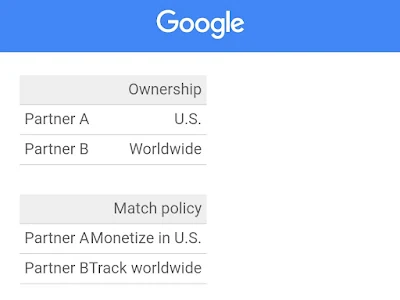Unlocking Revenue, Mastering Multi-Party Content Ownership on YouTube
 |
| Monetize YouTube Asset |
Understanding Shared Ownership
In the digital age, content often has multiple owners, particularly when dealing with different geographical territories. For instance, one party might own the rights to a film in the United States, while another holds the rights for Canada.
YouTube provides a framework for declaring this territorial ownership, ensuring that the correct partner retains control and can monetize their intellectual property.
This is crucial, as inaccurate or incomplete ownership details can hinder revenue generation by impacting YouTube's ability to claim videos and display ads.
Navigating Ownership Conflicts
A fundamental principle on YouTube is that each asset, within a specific territory, can have only one content owner. This principle, however, has an exception for Sound Recording assets, where publishing rights might be shared by multiple owners in a given territory. Attempting to declare ownership in a territory where another partner has already done so leads to an ownership conflict, potentially hindering monetization efforts.
Identifying Ownership Discrepancies
YouTube offers several avenues to verify and rectify asset ownership details:
Content ID:
Utilize the “All Assets” and “Ownership” filters within the Assets section to locate assets where ownership might not be established. The "Conflicting Ownership" filter helps identify assets currently under ownership disputes.
Dashboard Monitoring:
Regularly review the dashboard's “Issues” section for notifications regarding assets with conflicting ownership.
Asset Reports:
Download comprehensive asset reports from the Reports section to gain a holistic view of your ownership information.
The Significance of Applied Policies in Shared Ownership
When multiple parties share ownership of an asset, understanding whose policy governs claims is paramount. This policy determines whether videos are monetized, tracked or blocked. For videos uploaded by users and claimed by a single asset, YouTube implements the policy of each partner within their designated territories. Let's explore various scenarios:
Scenario 1: One Partner is missing Ownership Information
In cases where one partner hasn't declared ownership information, YouTube applies a "Track" policy for the territories where ownership is unclear. This situation can impact revenue, as illustrated by the example of Partner A and Partner B.
Result:- The video is monetized in France, Germany, and Spain, per Partner A’s policy, and Partner A receives this revenue.
- The video is blocked in Norway, Sweden, and Finland, per Partner B’s policy.
- YouTube applies a Track policy in the rest of the world, where ownership information is missing.
Scenario 2: Unset Policy by one Partner
If a partner hasn't defined a match policy, YouTube refrains from applying any policy in their territories, even if they hold ownership. This can lead to missed monetization opportunities.
Result:
- The video is monetized in Japan and tracked in Korea, per Partner A’s policy, and Partner A receives the revenue from Japan.
- YouTube applies no policy in the rest of the world, because partner B owns the asset but set no policy.
If you’re Partner B, you would want to set a match policy so that you can control (and monetize) your content in your territories of ownership.
Scenario 3: Conflicting Ownership Claims
When partners declare conflicting ownership, YouTube enforces the most restrictive policy, often resulting in content being tracked instead of monetized. It's in the best interest of all parties to resolve such conflicts swiftly.
 |
| Conflicting Ownership Claims |
Result:
- The video is tracked worldwide.
- Since there’s an ownership conflict in the U.S., YouTube applies the more restrictive policy, which is Track.
These partners would want to resolve their ownership conflict. If you’re Partner A, you’re missing out on monetization for as long as the conflict exists.
- You can examine the applied policy and owner policy from the claim information page.
- If an asset owner doesn’t set a policy in a territory they have ownership, YouTube applies no policy there.
- During ownership conflicts, if the asset owners have different match policies, YouTube applies the most restrictive policy to claims.
The applied policy per territory factors in the owner policy as well as any partner-level or global admin policy, which could be a business rule specified in a global agreement, such as don’t monetize in certain countries.
Collaboration Is Key in Shared Ownership
Managing shared ownership effectively hinges on collaboration. Checking for potential duplicate assets created by other partners and addressing any ownership inconsistencies is crucial. Additionally, language variations in content necessitate careful consideration. If you possess worldwide rights to a particular language version, establishing a separate asset is recommended. However, it's essential to note that certain dubbed content might not meet the criteria to serve as a Content ID reference.
Understanding Claim Disputes
In situations involving multiple asset owners, any owner can take action on claims, including handling disputes and appeals. A single claim is shared by all owners, meaning the first owner to respond to a dispute determines the outcome for all. This shared responsibility underscores the importance of clear communication and coordination among co-owners.
By following these guidelines and maintaining open communication with your fellow content owners, you can navigate the complexities of shared ownership on YouTube and unlock the full revenue potential of your content.


.png)



No comments:
Post a Comment